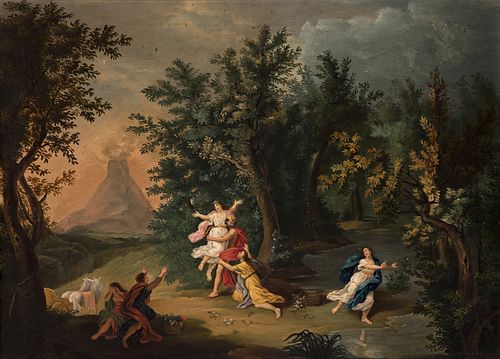French school; middle of the XVIII century. "The Rape of Proserpina". Oil on canvas. Relined.
Lot 24
About Seller
Setdart Auction House
Carrer Aragó 346
Barcelona
Spain
Setdart Subastas was born in 2004 and is currently the first online art auction in Spain with solidity, prestige and reliability guaranteed by our more than 60,000 users. Setdart has a young, dynamic and enterprising team ready to successfully manage the purchase and sale of art works through custom...Read more
Estimate:
EUR€900 - EUR€1,000
$967.74 - $1,075.27
Absentee vs Live bid
Two ways to bid:
- Leave a max absentee bid and the platform will bid on your behalf up to your maximum bid during the live auction.
- Bid live during the auction and your bids will be submitted real-time to the auctioneer.
Bid Increments
| Price | Bid Increment |
|---|---|
| EUR€0 | EUR€10 |
| EUR€200 | EUR€25 |
| EUR€500 | EUR€50 |
| EUR€1,000 | EUR€100 |
| EUR€3,000 | EUR€200 |
| EUR€5,000 | EUR€500 |
| EUR€10,000 | EUR€1,000 |
| EUR€20,000 | EUR€2,000 |
| EUR€50,000 | EUR€5,000 |
About Auction
By Setdart Auction House
Nov 3, 2021
Set Reminder
2021-11-03 08:00:00
2021-11-03 08:00:00
America/New_York
Bidsquare
Bidsquare : OLD MASTERS
https://www.bidsquare.com/auctions/setdart-auction-house/old-masters-7786
Setdart Auction House sofia@setdart.com
Setdart Auction House sofia@setdart.com
- Lot Description
French school; middle of the XVIII century. "The Rape of Proserpina". Oil on canvas. Relined. Presents period frame. Measurements: 51 x 68.5 cm; 64.54 x 82 cm (frame). In this work a mythological scene is developed, in spite of the smallness of the figures with respect to the landscape, the great dynamism of the same ones in their attitudes and expressions is appreciated. In the center a man with a crown (Hades), holds a young woman, also crowned, in his arms. The woman opens her arms and seems to cry out, asking for help. Other characters seem to try to rescue her, while others cover their faces and run away terrified. It is interesting to mention the artist's knowledge of classical mythology, a trait that is reflected not only in the conjunction of the chosen characters, but also in nature, as he portrays the volcano and Lake Pergusa, both in Sicily, the place where this mythological narrative is set. Finally, it is worth mentioning that the play differs in a certain way from the text, since in it it is said that the horses of Hades' chariot are black, while here they are white. The play stages an issue of classical mythology. Hades, god of the underworld, in love with the beauty of Proserpina or Persephone, abducted her and took her to his domain. The disappearance of the young girl would cause the despair of her mother, to the point of abandoning Olympus, leaving her functions, among which were the growth and maturation of vegetation, the protection of the natural life of the earth. Seeing the world wither and humanity succumb to hunger, Zeus himself had to intervene, who managed to get Hades to return the girl half the year, while the rest of the time the girl would live in the underworld, as the wife of the god, corresponding, in theory, this distribution, with the seasons. The moment represented is the one in which the god snatches the girl, to the despair of the girls who accompanied her.
- Shipping Info
-
In-house shipping available. Please inquire at admin@setdart.com.
-
- Buyer's Premium



 EUR
EUR CAD
CAD AUD
AUD GBP
GBP MXN
MXN HKD
HKD CNY
CNY MYR
MYR SEK
SEK SGD
SGD CHF
CHF THB
THB















